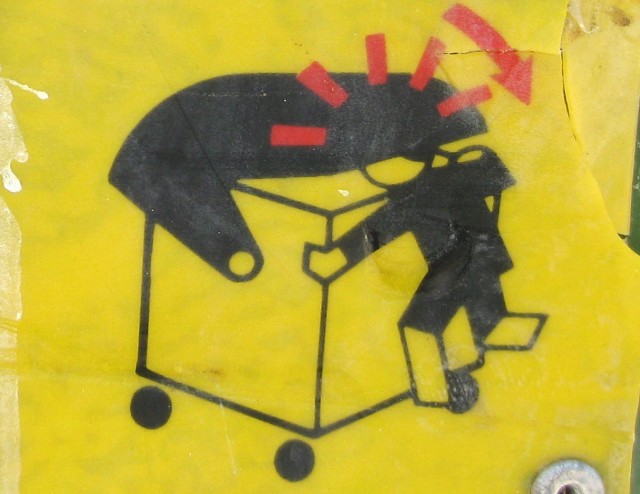5 Ideas Trapping The Advertising Industry Right Now
I recently read and liked this post on structuring your culture for innovation by Mark Pollard, VP Brand Strategy at Big Spaceship. And being the top bloke that he is, Mark agreed to take these thoughts a bit further and write this exclusive Adverblog post. In it he challenges us all on five ideas that hold back a lot of good advertisers.
5 Ideas Trapping The Advertising Industry Right Now
Recently, I was playing Frisbee with my six-year-old at Coney Island Beach when eight-year-old Frankie joined in. I asked Frankie where his black eye came from. “This kid was cursin’ at me at school so I popped him in the stomach and then he head-butted me,” he replied. Shortly after, three other local boys joined in and we switched to a game of volleyball. Things seemed to be going well, but as I turned to pick the ball up, these three kids started racially cussing Frankie who was now backing up toward his older brother, throwing out a big chest, flaring his arms like a seagull on speed, and challenging the kids to throw down. Frankie’s fourteen-year-old brother coached him to stand his ground, saying, “It’s a cold world out there.”
As Frankie and his predators performed their war dance, I couldn’t help but think how stuck they were. The ideas that they were acting out to help them survive their Coney Island existence may ultimately trap them. What’s worse is that they needed this incident to validate their ideas about themselves and how their world works. After all, ideas compel behavior - and ideas that compel this sort of behavior encourage this sort of situation.
But you know what? Coney Island Beach fights aren’t a whole lot different to working in advertising. The amount of misbehavior has always amazed me – the politics, the power-playing, the office scandals, the financial gouging, the summary firings, the tantrums and the manipulation. Sure, you can get Darwin on me and blame evolution, but, at some point, we need to own our shit. Or, rather, we need to own our ideas about the experience of working in advertising.
The most common conversation I have with people from the industry who are in their late 20s and early 30s is about what happens after advertising. There are more options than ever and, while choice causes distraction, most of these people talk about the frustration of working in slow-moving, bureaucratic, and departmentalized environments. You couldn’t get away with treating people on the street the way many agencies treat their people – and too few agencies are true meritocracies. Even clients are calling out the agency operating models. It’s amazing how an industry of ideas has so few ideas for itself.
Here are some of the ideas that have “death throe” stamped all over them.
1. Digital is somebody else’s problem
If you’re in a large agency and C-Level leaders don’t take an active role in helping your agency become more digitally capable, then leave. Seriously. If they outsource the problem to another company to come in and audit your agency to work out what’s wrong rather than talking to the people they lead, leave. If they are incapable of leading both structural and cultural change with their own people and their clients, then hiring a couple of people who get digital isn’t going to solve the problem. There’s a whole generation of golden parachutes waiting for their payouts - they’re not just delegating change to somebody else, they’re delegating it to a whole other generation.
Digital is everybody’s problem. Exciting, right?
2. Creativity is a department
Most large agencies are really in the business of account management and project management. That’s how they make their money – bums on seats. Few large agencies have any incentive to create smaller cross-functional teams that have less layers between the makers and the clients. Nor do most have any incentive to work faster. When creativity is a department and not just something expected of everyone who turns up to work, then clients are paying for a whole lot of the wrong thing. Mind you the agency-side bureaucracy requires a client-side bureaucracy too… did somebody say Ponzi scheme?
3. Acting like change is happening is the same as change happening
Many consultancies and education companies make a ton of money by helping agency management act like things are changing. But change rarely happens if jobs don’t depend on change happening. Jazz-hands can only work for so long.
4. It’s the agency’s problem
If an agency wants to change, it can only change as much and as fast as its clients will letit. You need only read “The Innovator’s Dilemma” to get a researched perspective on this – innovation often happens best in a separate entity that’s allowed to create its own culture and find new revenue without disrupting legacy clients. Over the past few years, many large clients I’ve worked with have realized that they have brought in too many agencies to work with. A common solution involves appointing one agency as lead agency to manage the others – this can work but ignores the fact that many people at that agency turn up to work every day to create, not merely orchestrate a bunch of other people.
5. Meeting the numbers matters more than culture
If you nerd out on behavioral economics, you’ve probably read “Drive” by Daniel Pink. Ironically, the numbers people have shown that soft stuff like purpose and culture drive performance. Yet how many people running large agencies or agency networks talk about culture? Much of the talk is about numbers, made-up trademarked processes, how many offices and staff they have.
One day the industry will pull itself out of these traps - hopefully before many of the good people leave the industry for less toxic environments.

Mark Pollard
———-
Now if you’ve made it this far, I think you have graduated to your opportunity to join Mark’s course about “Explaining Ideas” on Skillshare.
Follow Mark on Twitter @markpollard and make sure to read his excellent blog Life. Then Strategy. And please leave a comment if this post strikes a chord with you.
Tim @tbuesing

